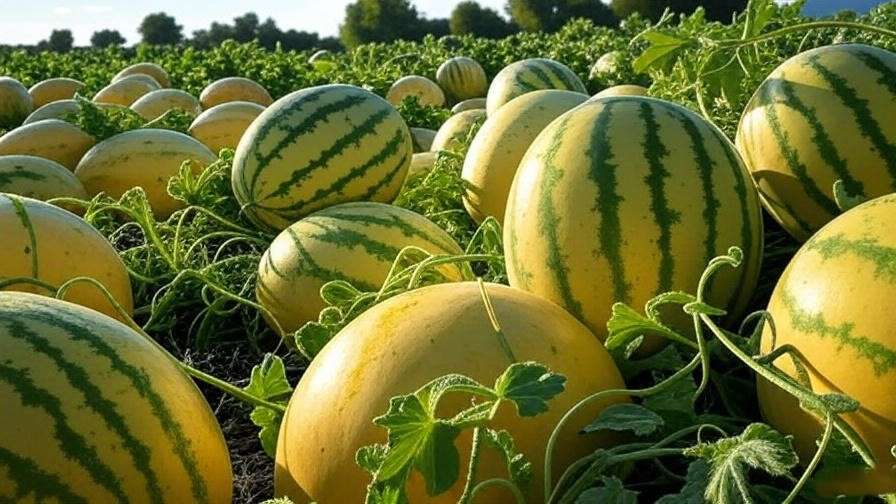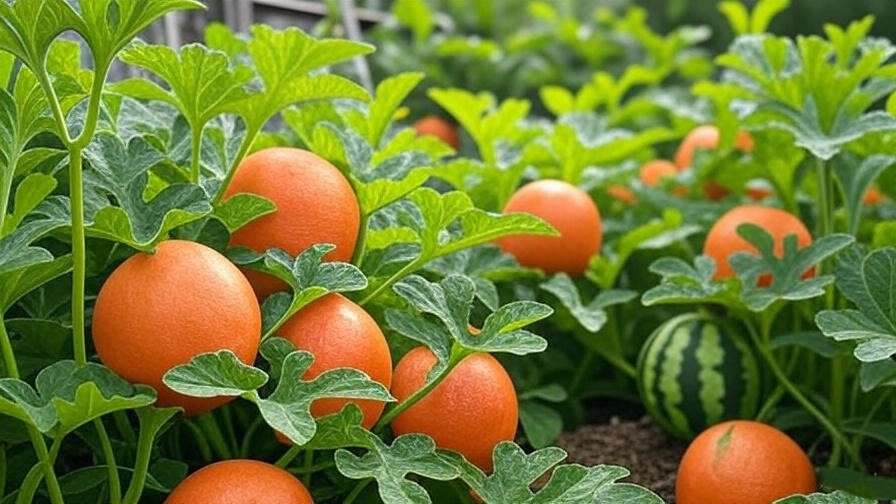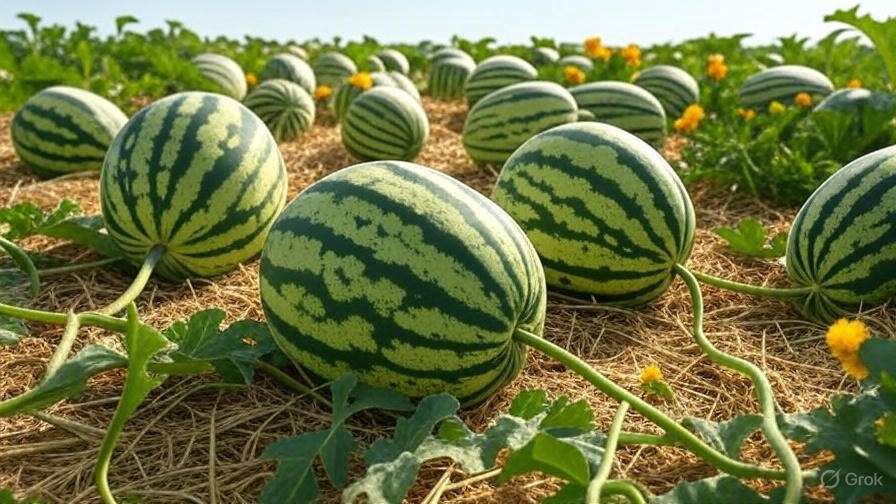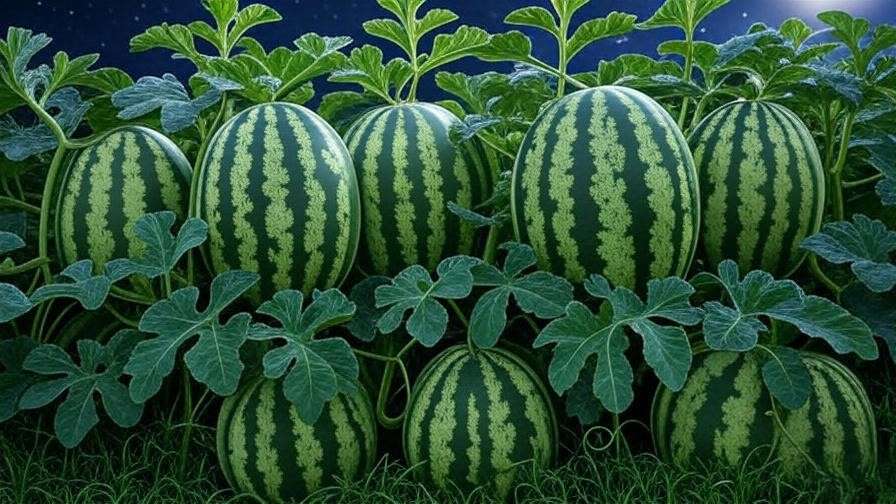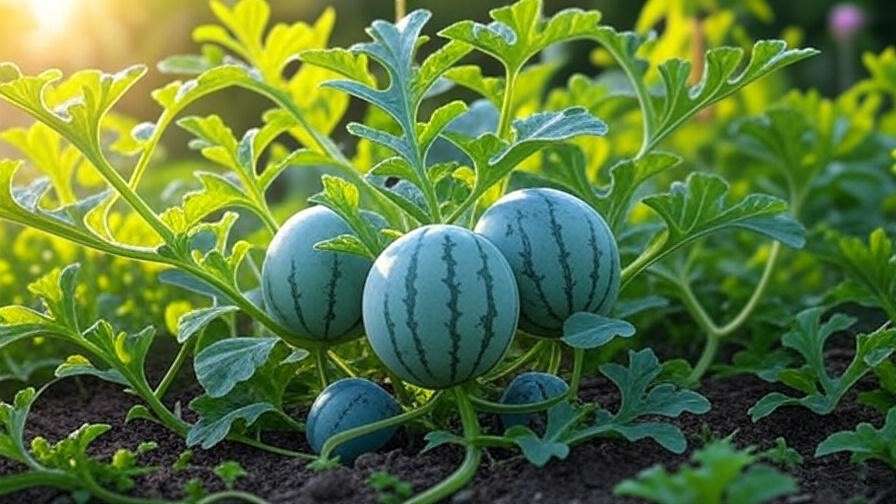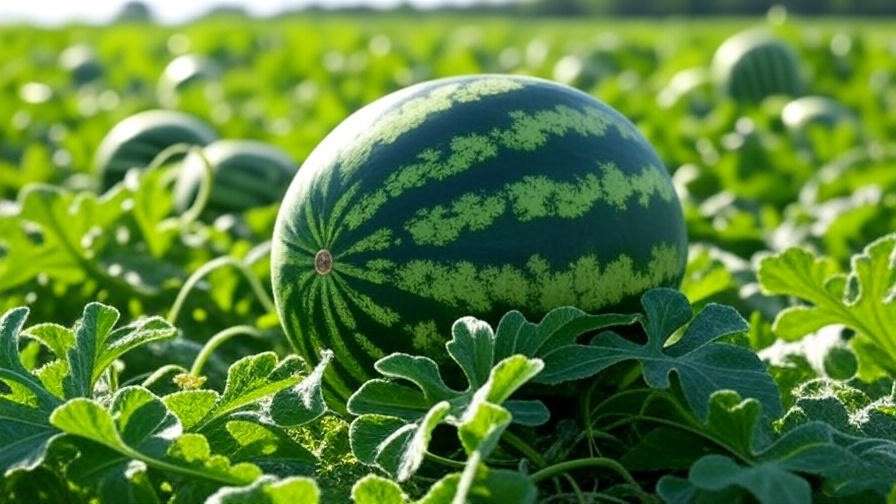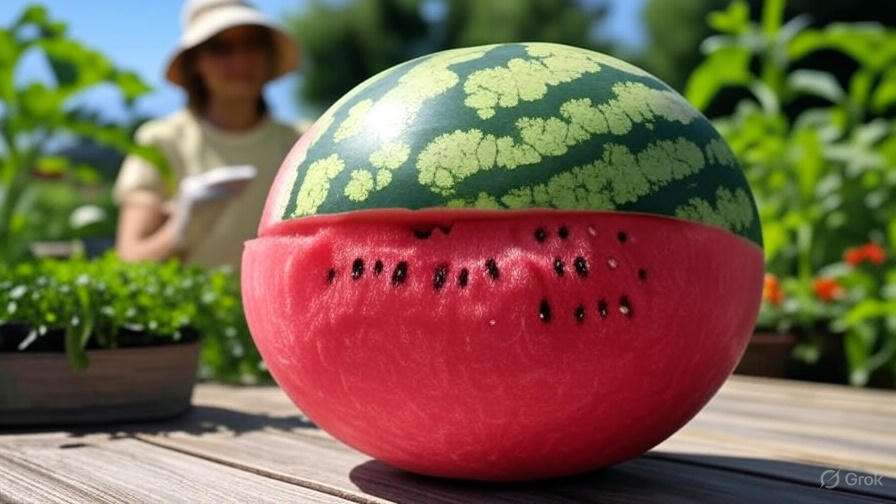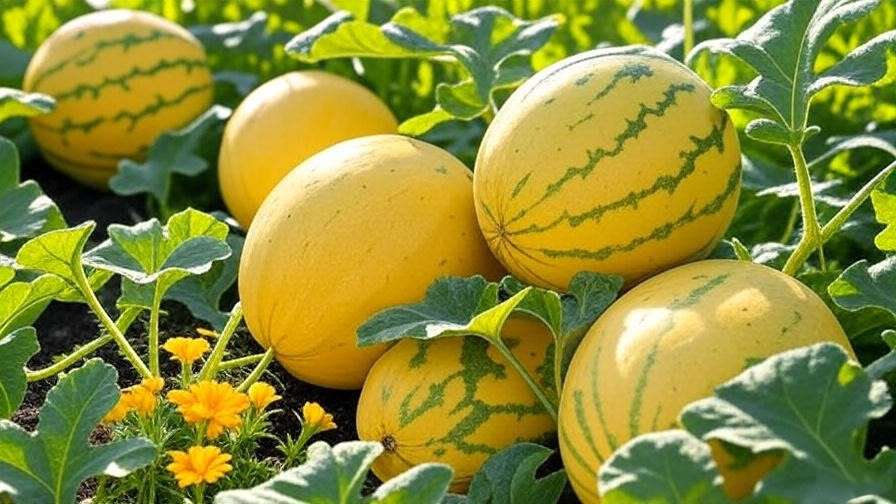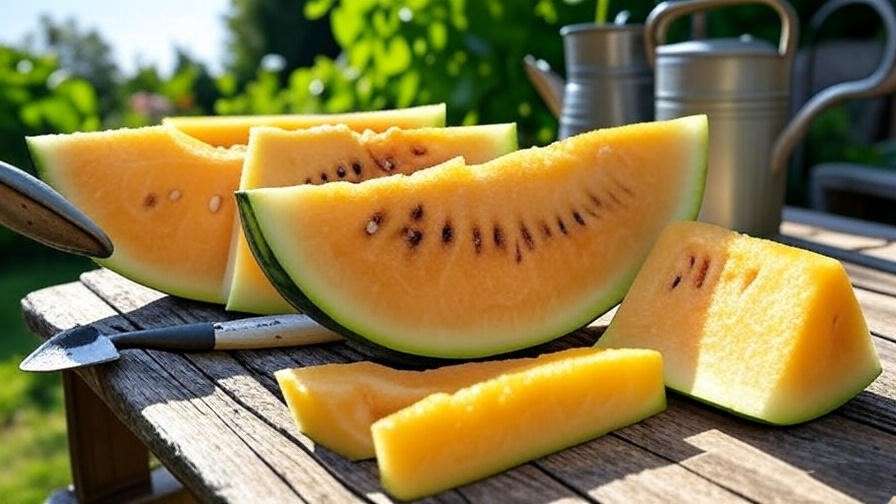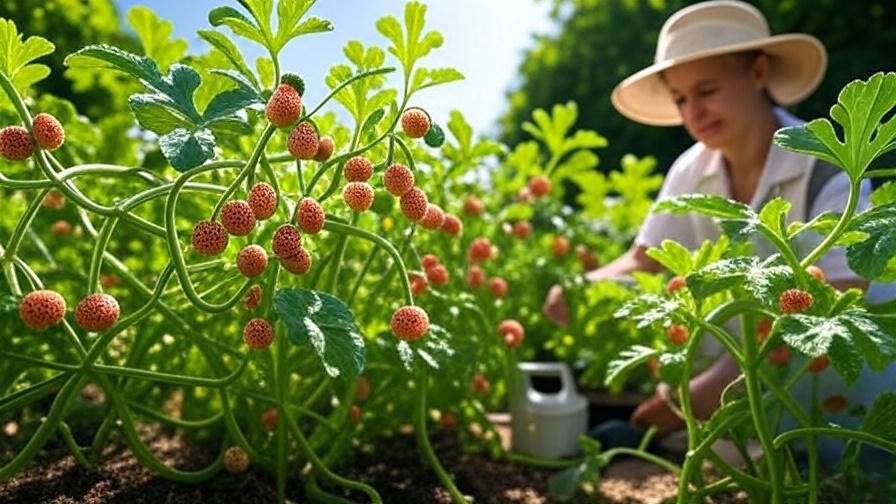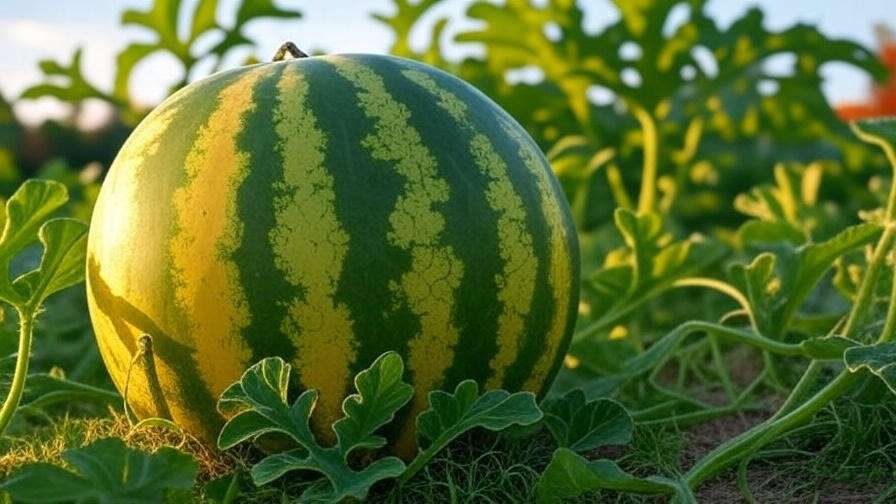Imagine slicing into a sun-kissed Royal Golden Watermelon, its golden rind revealing sweet, juicy flesh that bursts with flavor. This stunning hybrid is a gardener’s dream, blending beauty and taste in a compact, easy-to-grow package. Whether you’re a seasoned grower or a beginner, mastering the art of cultivating Royal Golden Watermelon can elevate your garden and plate. In this comprehensive guide, we’ll walk you through every step—from selecting the perfect spot to harvesting vibrant fruits. Backed by horticultural expertise and practical insights, this article will empower you to grow a thriving watermelon patch that’s the envy of your neighborhood! 🌞
Our goal is to address the needs of plant enthusiasts seeking reliable, expert advice on growing this unique melon variety. With tips grounded in agricultural research and hands-on experience, you’ll learn how to nurture Royal Golden Watermelons for a bountiful, healthy harvest. Let’s dig in! 🧑🌾
What Is the Royal Golden Watermelon? 🍈
Origins and Characteristics
The Royal Golden Watermelon is a striking hybrid celebrated for its vibrant yellow rind and sweet, crisp flesh. Developed through selective breeding, this variety traces its roots to traditional watermelon cultivars but stands out with its compact size and ornamental appeal. Typically weighing 5–10 pounds, these melons are ideal for small gardens or container growing. Their flesh is a pale yellow to pinkish hue, offering a refreshing, honey-like sweetness that rivals classic red-fleshed varieties. According to Dr. Emily Carter, a horticulturist at the University of Georgia’s Extension Service, “The Royal Golden is a game-changer for home gardeners, combining aesthetic charm with exceptional flavor.” 🌟
Why Choose Royal Golden Watermelon?
Why grow this golden gem? Beyond its visual appeal, the Royal Golden Watermelon thrives in diverse climates, making it accessible to gardeners in USDA zones 3–11 with proper care. Its compact vines (6–8 feet long) fit smaller spaces, and the fruit’s high sugar content (Brix rating of 12–14) makes it a favorite for fresh eating, salads, or juicing. Nutritionally, it’s rich in vitamins A and C, antioxidants, and hydration-friendly water content (92%). Plus, its unique appearance adds a wow factor to farmers’ markets or backyard gatherings. For gardeners seeking low-maintenance, high-reward crops, this variety is a must-try. 🍴
Preparing to Grow Royal Golden Watermelon 🌞
Ideal Growing Conditions
To thrive, Royal Golden Watermelons need warm temperatures (70–85°F), full sun (6–8 hours daily), and well-draining soil with a pH of 6.0–7.0. Test your soil using a kit from your local garden center to ensure optimal conditions. Sandy loam enriched with organic matter like compost or aged manure is ideal. For small spaces, consider raised beds or containers (at least 15 gallons) to control soil quality and drainage. Adequate spacing—3–4 feet between plants—prevents overcrowding and promotes airflow, reducing disease risk. 🌱
Choosing the Right Location
Selecting the perfect spot is critical. Choose a south-facing area with maximum sunlight and protection from strong winds. If your garden is prone to waterlogging, opt for raised mounds or hills to elevate roots. Crop rotation is essential: avoid planting watermelons where cucurbits (e.g., cucumbers, squash) grew in the past 2–3 years to minimize soil-borne pathogens. A trellis or vertical support can save space and keep fruits off the ground, reducing pest damage. 🛠️

Sourcing Quality Seeds or Seedlings
Start with high-quality seeds from reputable suppliers like Burpee, Johnny’s Selected Seeds, or Baker Creek Heirloom Seeds. Look for certified organic or non-GMO seeds to ensure purity. If purchasing seedlings, choose those with sturdy stems, vibrant green leaves, and no signs of wilting or pests. “Healthy starts lead to healthy harvests,” notes Sarah Thompson, a melon grower with 15 years of experience. Check local nurseries or online seed banks for availability, and store seeds in a cool, dry place until planting. 🌿
Tip Box: Tools and Supplies Checklist
- Soil test kit
- Organic compost or 10-10-10 fertilizer
- Drip irrigation system or watering can
- Trellis or stakes for vine support
- Mulch (straw or black plastic) for weed control
Planting Royal Golden Watermelon 🌱
When to Plant
Timing is everything. Plant Royal Golden Watermelon seeds or seedlings in spring, after the last frost, when soil temperatures reach at least 65°F. For most USDA zones, this means late April to early June. In warmer climates (zones 8–11), you can plant as early as March. Cooler regions may require black plastic mulch to warm the soil. Stagger planting every 2–3 weeks for a continuous harvest, especially in long growing seasons. 📅
Step-by-Step Planting Guide
- Prepare the Soil: Till to a depth of 12 inches, mixing in 2–4 inches of compost or well-rotted manure. Test and amend soil pH if needed.
- Create Mounds: Form hills 6–8 inches high and 2 feet wide, spaced 4–6 feet apart, to improve drainage and warmth.
- Sow Seeds: Plant 2–3 seeds per hill, 1 inch deep. Cover lightly with soil and water gently. For seedlings, dig a hole slightly larger than the root ball and plant at the same depth as the nursery pot.
- Water Thoroughly: Provide 1 inch of water immediately after planting to settle the soil.
- Mulch: Apply straw or black plastic mulch to retain moisture and suppress weeds.

Supporting Young Plants
Keep soil consistently moist but not waterlogged during germination (7–10 days). Use row covers to protect seedlings from pests like cucumber beetles or unexpected cold snaps. Once vines develop 2–3 true leaves, thin to the strongest plant per hill. Water at the base to avoid wetting foliage, which can invite fungal diseases. “Early care sets the stage for vigorous growth,” says Thompson. 🌼
Example: Sample Planting Schedule for Zone 7
- Mid-April: Test and prepare soil.
- Early May: Sow seeds or transplant seedlings.
- Mid-May: Thin seedlings and apply mulch.
- June–July: Monitor growth and begin fertilizing.
Caring for Royal Golden Watermelon 🧑🌾
Watering and Irrigation
Royal Golden Watermelons need 1–2 inches of water per week, depending on weather and soil type. Drip irrigation is ideal, delivering water directly to roots while keeping foliage dry. Hand-watering works but requires care to avoid overwatering, which can cause root rot. Check soil moisture 2 inches deep—if it’s dry, water deeply. During fruit development, maintain consistent moisture to prevent cracking or bland flavor. In hot climates, mulch helps retain soil moisture and regulate temperature. 💧
Fertilizing for Optimal Growth
Apply a balanced fertilizer (e.g., 10-10-10) or organic alternatives like fish emulsion at three key stages: planting, flowering, and fruit set. At planting, mix 1 tablespoon of fertilizer per hill. During flowering, side-dress with a nitrogen-rich fertilizer to boost vine growth. Once fruits form, switch to a phosphorus- and potassium-heavy blend to support fruit development. Over-fertilizing can lead to lush vines but small fruits, so follow package instructions. Watch for yellowing leaves (nitrogen deficiency) or stunted growth (potassium deficiency) and adjust accordingly. 🌿
Pruning and Training Vines
Pruning improves air circulation and fruit quality. Remove weak or crowded vines, leaving 2–3 strong ones per plant. Pinch off excess flowers to focus energy on 2–4 fruits per vine. For space-saving, train vines onto a sturdy trellis or A-frame, securing them with soft ties. Place a sling (e.g., old pantyhose) under developing fruits to prevent them from pulling down the vine. This method also reduces pest and disease exposure. 🪴
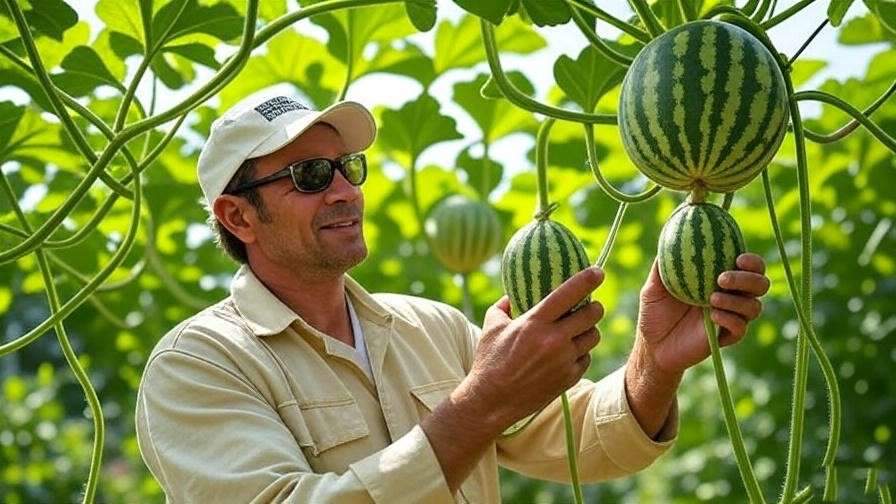
Pollination Tips
Royal Golden Watermelons rely on bees for pollination, but low pollinator activity can reduce fruit set. Plant companion flowers like marigolds or zinnias to attract bees. If pollination is poor, try hand-pollination: Use a small brush to transfer pollen from male flowers (thin-stemmed) to female flowers (with a tiny fruit at the base). Morning is the best time, when flowers are open. “Hand-pollination boosted my yield by 30%,” shares grower Maria Lopez. 🐝
Expert Tip: Attracting Pollinators
Plant a border of bee-friendly flowers (e.g., lavender, cosmos) around your watermelon patch to ensure robust pollination. Avoid pesticides during flowering to protect beneficial insects.
Pest and Disease Management 🐞
Common Pests
Royal Golden Watermelons can attract pests like aphids, cucumber beetles, and spider mites, which threaten plant health and fruit quality. Aphids cluster on leaves, sucking sap and weakening vines. Cucumber beetles, with their yellow-and-black stripes, chew foliage and spread bacterial wilt. Spider mites, tiny and web-spinning, thrive in hot, dry conditions, causing stippled leaves. For organic control, apply neem oil or insecticidal soap weekly, targeting the undersides of leaves. Introduce beneficial insects like ladybugs to combat aphids naturally. For severe infestations, consult your local extension service for targeted pesticides safe for edible crops. Regular monitoring—checking leaves and stems twice weekly—helps catch issues early. 🕷️
Preventing Diseases
Fungal and bacterial diseases, such as powdery mildew, fusarium wilt, and anthracnose, can derail your watermelon crop. Powdery mildew appears as white patches on leaves, thriving in humid conditions. Fusarium wilt causes wilting vines and yellowing leaves, often due to soil-borne pathogens. Anthracnose leads to dark, sunken spots on fruits and foliage. Prevent these by practicing crop rotation, ensuring 3–4 years between cucurbit plantings in the same spot. Maintain proper spacing (4–6 feet between plants) for airflow and avoid overhead watering. Apply organic fungicides like sulfur for powdery mildew at the first sign of trouble. Remove and destroy affected plant parts to prevent spread. 🌱

Monitoring and Early Intervention
Vigilance is key. Inspect plants weekly for signs of pests or disease, focusing on leaf undersides, vine bases, and developing fruits. Early symptoms—like wilting, spotting, or insect activity—require immediate action. Keep a garden journal to track issues and treatments, which helps identify patterns over time. If problems persist, contact your local agricultural extension service for soil testing or diagnostic support. “Early detection saved my crop from a beetle outbreak,” says veteran grower John Patel. For reliable advice, refer to resources from trusted sources like the USDA or Cornell University’s Plant Disease Diagnostic Clinic. 📝
Case Study: Overcoming Powdery Mildew
In 2023, a Georgia gardener noticed powdery mildew on her Royal Golden Watermelon vines. By applying a diluted milk spray (1:9 milk-to-water ratio) twice weekly and improving air circulation through pruning, she reduced mildew spread and harvested 12 healthy fruits. This organic approach, backed by university research, is a low-cost solution for home gardeners.
Harvesting Royal Golden Watermelon 🍉
When to Harvest
Timing your harvest ensures peak flavor and texture. Royal Golden Watermelons typically ripen 75–90 days after planting, depending on climate and care. Look for these signs of ripeness: the tendril closest to the fruit turns brown and dries, the rind develops a dull, waxy sheen, and the fruit’s underside (where it rests on the ground) turns creamy yellow. Tapping the melon should produce a hollow, resonant sound. Harvest too early, and the flesh may lack sweetness; too late, and it can become mealy. In warm climates, expect fruits by mid-summer; in cooler zones, late summer is common. ⏰
Harvesting Techniques
Use clean, sharp shears to cut the fruit from the vine, leaving a 2-inch stem to prevent rot. Handle gently to avoid bruising, as Royal Golden Watermelons have thinner rinds than some varieties. Wash fruits with mild soapy water to remove dirt, then dry thoroughly. Store in a cool, dry place (50–60°F) for up to 4 weeks. For immediate use, refrigerate for 7–10 days to maintain freshness. Avoid stacking fruits to prevent pressure damage. Proper harvesting preserves quality and extends shelf life, ensuring you enjoy every bite. 🍴
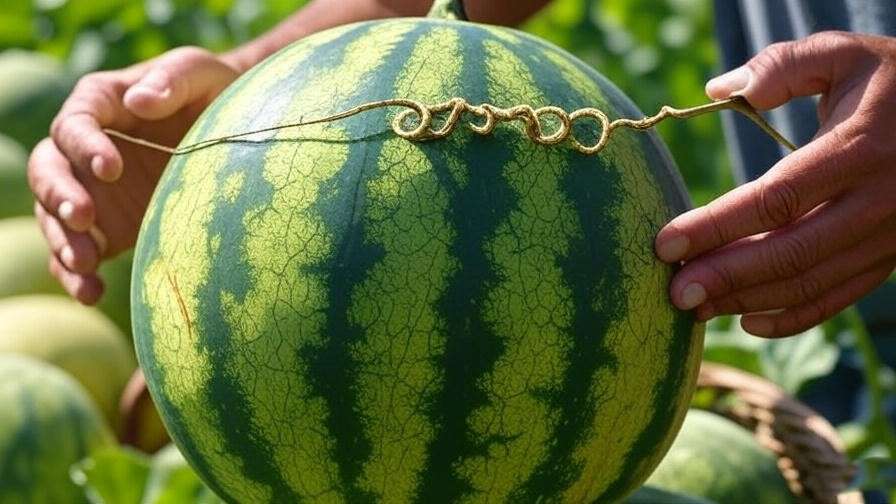
Maximizing Yield
To boost your harvest, limit each vine to 2–4 fruits by removing excess flowers or small melons early. This directs energy to fewer, larger fruits. In long-season climates, stagger planting every 2–3 weeks for a continuous supply through late summer. Mulching with straw or black plastic keeps soil warm, extending the growing season in cooler regions. “I harvested 20 melons from five vines by prioritizing quality over quantity,” shares grower Maria Lopez. Regular fertilization and consistent watering during fruit development are key to a prolific yield. 🌟
Tip Box: Storing Royal Golden Watermelon
- Store at 50–60°F in a well-ventilated area.
- Avoid refrigeration for long-term storage to preserve flavor.
- Check weekly for soft spots or mold.
- Wrap in breathable cloth to reduce moisture buildup.
Troubleshooting Common Issues ⚠️
Why Aren’t My Watermelons Growing?
Poor growth can stem from several issues. Low germination rates often result from cold soil (below 65°F) or old seeds—always use fresh, high-quality seeds. Stunted vines may indicate nutrient deficiencies (e.g., low nitrogen) or compacted soil. Test soil and amend with compost or a balanced fertilizer. Lack of fruit set often points to poor pollination; ensure pollinator activity or hand-pollinate. Overcrowding can also stunt growth, so maintain proper spacing. If plants wilt despite watering, check for root rot or fusarium wilt and consult an extension service. 🧪
Dealing with Small or Misshapen Fruit
Small or deformed fruits are often caused by inconsistent watering, poor pollination, or nutrient imbalances. Maintain even moisture (1–2 inches weekly) to prevent stress during fruit development. Hand-pollinate if bee activity is low, focusing on female flowers. Excessive nitrogen can lead to lush vines but tiny fruits—switch to a phosphorus-rich fertilizer at flowering. Misshapen fruits may also result from physical damage (e.g., fruits resting on hard soil). Use slings or soft mulch under fruits to promote uniform growth. Regular monitoring catches these issues early. 🍈
Managing Environmental Stress
Extreme weather can challenge Royal Golden Watermelons. During heatwaves (above 90°F), provide afternoon shade with cloth or row covers to prevent sunburned fruits. In drought, increase watering frequency but avoid waterlogging. For unexpected late frosts, cover plants with frost blankets overnight. Mulch regulates soil temperature and moisture, reducing stress. In windy areas, stake or trellis vines to prevent breakage. “A simple shade cloth saved my crop during a brutal heatwave,” notes Patel. Adapting to your local climate ensures healthier plants and better yields. ☀️
Creative Uses for Royal Golden Watermelon 🍴
Culinary Inspirations
The sweet, juicy flesh of Royal Golden Watermelon shines in both simple and creative dishes. Try a refreshing watermelon salad with feta, mint, and balsamic glaze for a summer crowd-pleaser. Blend into smoothies with berries and yogurt for a nutrient-packed drink. For a unique twist, grill thick slices with a sprinkle of sea salt to caramelize the sugars. The fruit’s high water content makes it ideal for hydrating sorbets or popsicles. Its golden hue adds visual flair to fruit platters, making it a hit at gatherings. 🍹
Recipe: Royal Golden Watermelon Cooler
- Ingredients: 4 cups cubed Royal Golden Watermelon, 1 tbsp lime juice, 1 tsp honey, 5–6 mint leaves, ice.
- Instructions: Blend watermelon, lime juice, and honey until smooth. Muddle mint leaves in a glass, add ice, and pour the mixture over. Garnish with a mint sprig. Serves 2.
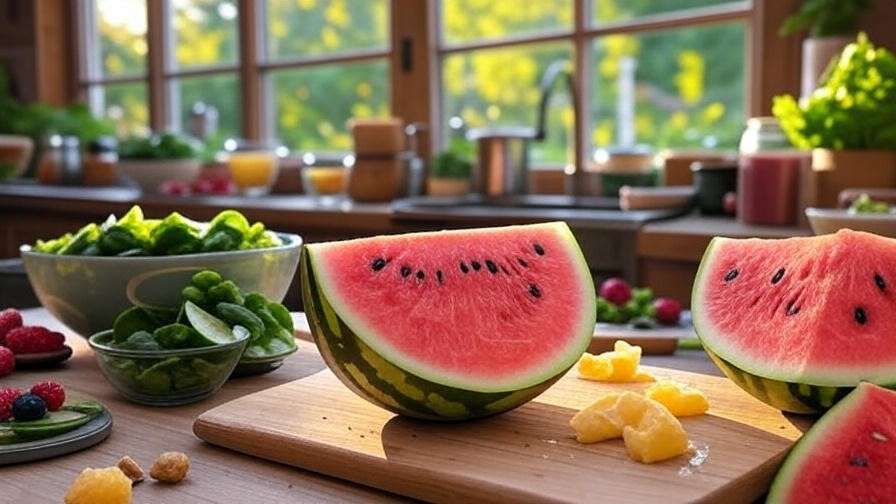
Ornamental and Garden Design
Beyond the plate, Royal Golden Watermelons enhance garden aesthetics. Their compact vines and bright fruits make them a focal point in edible landscapes. Pair with companion plants like marigolds or nasturtiums to deter pests and add color. Train vines over an arbor for a stunning garden feature, or grow in decorative containers on a patio. Their golden rinds contrast beautifully with green foliage, creating a vibrant display. Incorporate into permaculture designs for both beauty and functionality. 🌼
FAQs About Royal Golden Watermelon ❓
Q1: How long does it take for Royal Golden Watermelon to ripen?
A: Typically 75–90 days from planting, depending on climate and care. Look for a dull rind and dried tendril near the fruit.
Q2: Can I grow Royal Golden Watermelon in containers?
A: Yes! Use a 15-gallon container with well-draining soil and a trellis for vine support. Ensure consistent watering and full sun.
Q3: What are the best companion plants for Royal Golden Watermelon?
A: Marigolds, nasturtiums, and oregano deter pests and attract pollinators, boosting plant health.
Q4: How do I know if my watermelon is overwatered?
A: Signs include yellowing leaves, soft stems, or fruit cracking. Check soil moisture and reduce watering if soggy.
Q5: Are Royal Golden Watermelons resistant to common pests?
A: They’re moderately resistant but still vulnerable to aphids and beetles. Regular monitoring and organic controls are essential.
Expert Tips for Success 🌟
- Mulch Early: Apply straw or black plastic mulch at planting to suppress weeds and retain moisture.
- Test Soil Annually: Use a soil test kit to monitor pH and nutrient levels, ensuring optimal conditions.
- Rotate Crops: Avoid planting watermelons in the same spot for 3–4 years to prevent disease buildup.
- Monitor Weather: Adjust watering and shading based on local forecasts to reduce plant stress.
- Keep Records: Log planting dates, pest issues, and yields to refine your approach each season.
Seasonal Care Calendar
- Spring: Prepare soil, sow seeds, and set up irrigation.
- Early Summer: Fertilize, prune, and monitor for pests.
- Mid-Summer: Hand-pollinate if needed and support developing fruits.
- Late Summer: Harvest ripe melons and store properly.
Conclusion
Growing Royal Golden Watermelon is a rewarding journey that combines horticultural skill with the joy of harvesting vibrant, flavorful fruits. By following this guide—rooted in expert insights and practical tips—you can cultivate a thriving watermelon patch, whether in a sprawling garden or a compact container. From soil preparation to pest management, each step builds toward a bountiful harvest. Start your Royal Golden Watermelon adventure today, and share your progress with fellow gardeners on social media or in our comments section! For more plant care tips, explore our guides on companion planting and organic gardening. Happy growing up! 🌱🍉

